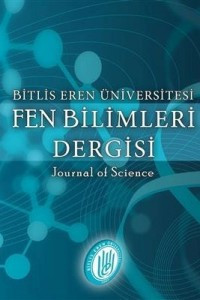Abstract
EN 197-1 standardına göre üretilen çimentoların dayanım sınıfları EN 196-1 standardına göre belirlenmektedir. EN 196-1 standardına göre yapılan çimento harcı üretimlerinde üretim tekniği olarak kaba önce su konulur, daha sonra çimento eklenerek 30 s düşük hızda çalıştırılır, sonraki 30 s sürede kum ilavesi yapılır, karıştırıcı 30 s yüksek hızda çalıştırılır, 90 s sonra cihaz durdurularak kabın içerisine yapışan harç temizlenerek karışıma ilave edilir ve üretime 60 s yüksek hızda devam edilerek üretim süreci tamamlanır. Üretim standardı belirlenmeyen harçların üretimlerinde ise homojenliği sağlamak üzere çoğunlukla önce kuru karışım (çimento-kum veya çimento-agrega), daha sora ise kuru karışıma gerekli su ilavesi yapılarak karışımın mümkün olduğunca homojenleştirilmesi sağlanmaktadır. EN 196-1 de belirtilen üretim tekniği ile diğer alternatif üretim tekniklerinin karşılaştırılması amacıyla yapılan bu çalışmada; 3 farklı firmadan temin edilen CEM I 42.5 R tipi çimento, kum ve suyun karışıma girme sıraları değiştirilerek ve EN 196-1 standardında belirtilen süreçler baz alınarak 6 farklı üretim tekniğine göre üretimler yapılmıştır. Üretilen örneklerin EN 1015-3 standardına göre yayılma değerleri, EN 12350-6 standardına göre taze yoğunluğu, EN 196-1 standardına göre 2, 7 ve 28 günlük dayanım özellikleri, EN 12390-7 standardına göre sertleşmiş yoğunluğu, Arşimet prensibine göre su emme yüzdeleri ve porozite değerleri ile EN 1015-18 standardına göre kılcal su emme katsayısı değerleri belirlenmiştir. Çalışmanın sonucunda işlenebilirlik açısından en uygun üretim tekniğinin kum-su-çimento sıralaması ile üretilen örneklerde olduğu, mekanik özellikler açısından ise en uygun üretim tekniğinin ise EN 196-1 standardında belirtilen üretim tekniği olduğu sonucuna varılmıştır.
References
- G. Kara, A. İbiç ve E. Yağcıoğlu. 2018. Çimento sektöründen kaynaklanan sera gazı emisyonları. Ulusal Çevre Bilimleri Araştırma Dergisi, 1 (2): 87-90.
- Methods of testing cement - Part 1: Determination of strength, EN Standard 196-1, 2016.
- Method of testing cement - Chemical analysis of cement, EN Standard 196-2, 2013.
- Methods of testing cement - Determination of setting times and soundness, EN Standard 196-3, 2016.
- Methods of testing cement - Pozzolanicity test for pozzolanic cement, EN Standard 196-5, 2011.
- Methods of testing cement - Determination of fineness, EN Standard 196-6, 2018.
- Methods of testing cement - Methods of taking and preparing samples of cement, EN Standard 196-7, 2007.
- Methods of testing cement - Heat of hydration - Solution method, EN Standard 196-8, 2010.
- Methods of testing cement - Heat of hydration - Semi-adiabatic method, EN Standard 196-9, 2010.
- Methods of testing cement - Determination of the water-soluble chromium (VI) content of cement, EN Standard 196-10, 2016.
- Methods of testing cement - Heat of hydration - Isothermal Conduction Calorimetry method, EN Standard 196-11, 2018.
- Specification for mortar for masonry - Part 2: Masonry mortar, EN Standard 998-2, 2016.
- Methods of test for screed materials - Part 1: Sampling, making and curing specimens for test, EN Standard 13892-1, 2002.
- Concrete - Part 1: Specification, performance, production and conformity, EN Standard 206-1, 2000.
- EFNARC, Specification and Guidelines for Self Compacted Concrete, Efnarc Association, Fernham UK, 2002.
- Methods of test for mortar for masonry - Determination of consistence of fresh mortar (by flow table), EN Standard 1015-3, 1999.
- Testing fresh concrete - Density, EN Standard 12350-6, 2019.
- Testing hardened concrete - Density of hardened concrete, EN Standard 12390-7, 2019.
- Methods of test for mortar for masonry - Determination of water absorption coefficient due to capillary action of hardened mortar, EN Standard 1015-18, 2002.
Abstract
References
- G. Kara, A. İbiç ve E. Yağcıoğlu. 2018. Çimento sektöründen kaynaklanan sera gazı emisyonları. Ulusal Çevre Bilimleri Araştırma Dergisi, 1 (2): 87-90.
- Methods of testing cement - Part 1: Determination of strength, EN Standard 196-1, 2016.
- Method of testing cement - Chemical analysis of cement, EN Standard 196-2, 2013.
- Methods of testing cement - Determination of setting times and soundness, EN Standard 196-3, 2016.
- Methods of testing cement - Pozzolanicity test for pozzolanic cement, EN Standard 196-5, 2011.
- Methods of testing cement - Determination of fineness, EN Standard 196-6, 2018.
- Methods of testing cement - Methods of taking and preparing samples of cement, EN Standard 196-7, 2007.
- Methods of testing cement - Heat of hydration - Solution method, EN Standard 196-8, 2010.
- Methods of testing cement - Heat of hydration - Semi-adiabatic method, EN Standard 196-9, 2010.
- Methods of testing cement - Determination of the water-soluble chromium (VI) content of cement, EN Standard 196-10, 2016.
- Methods of testing cement - Heat of hydration - Isothermal Conduction Calorimetry method, EN Standard 196-11, 2018.
- Specification for mortar for masonry - Part 2: Masonry mortar, EN Standard 998-2, 2016.
- Methods of test for screed materials - Part 1: Sampling, making and curing specimens for test, EN Standard 13892-1, 2002.
- Concrete - Part 1: Specification, performance, production and conformity, EN Standard 206-1, 2000.
- EFNARC, Specification and Guidelines for Self Compacted Concrete, Efnarc Association, Fernham UK, 2002.
- Methods of test for mortar for masonry - Determination of consistence of fresh mortar (by flow table), EN Standard 1015-3, 1999.
- Testing fresh concrete - Density, EN Standard 12350-6, 2019.
- Testing hardened concrete - Density of hardened concrete, EN Standard 12390-7, 2019.
- Methods of test for mortar for masonry - Determination of water absorption coefficient due to capillary action of hardened mortar, EN Standard 1015-18, 2002.
Details
| Primary Language | Turkish |
|---|---|
| Subjects | Engineering |
| Journal Section | Araştırma Makalesi |
| Authors | |
| Publication Date | March 24, 2022 |
| Submission Date | June 16, 2021 |
| Acceptance Date | December 13, 2021 |
| Published in Issue | Year 2022 Volume: 11 Issue: 1 |


